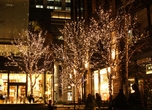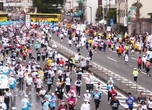
Posted: Tue Nov 16 2010
Every November 7, a slew of Tori no Ichi festivals open for celebration. This year, the Tori no Ichi festivities will be going on right up until Ni no Tori on Nov 19, celebrating the ever-shortening days and the onset of the Tokyo winter. With so many shrines honouring their deities at the same time, there’s a huge rush to enjoy the festivals and herald the coming of the winter.
Fri Nov 14 Tori no Ichi (Ni no Tori)
Asakusa Tori no Ichi (Chokoku-ji Temple & Ootori Jinja Shrine)
Originating in the Edo period and still going strong today, both the festival and the shrine at which it started, Ootori Jinja Shrine, are known throughout Japan. The festival is popular because it takes place at both a Shinto shrine and a Buddhist temple – meaning visitors can pray for the blessings of deities from both religious traditions. At Chokoku-ji Temple’s Tori no Ichi, there are larger kumade (bamboo rakes) on offer as well as many auspicious sweets such as nigiri yaki and mini yaki baked in the shape of the temple’s crest. (Event details)
Tori no Ichi (Ootori Jinja Shrine, Meguro)
Visitors gather to pray for good luck and prosperity in business here – partly because the name of the shrine, Ootori, has an alternate reading that means a ‘large gain in wealth’. At both Ichi no Tori and Ni no Tori, from 7pm visitors can enjoy ancient Shinto music and dance performances using kumade. (Event details)
Ootori Festival (Hanazono Jinja Shrine, Shinjuku)
Ootori Festival is a large-scale Tori no Ichi that hosts as many as 60 stalls selling kumade and 200 stalls selling other festival commodities. Hanazono speciality products and misemono-goya (a traditional side-show circus) can also be found here. On the evening of Thursday November 18 the pre-night festival will be held. (Event details)
Tori no Ichi (Miyamasu Mitake Jinja Shrine, Shibuya)
Located approximately halfway up Miyamasu-zaka Road in Shibuya, this shrine welcomes visitors with two komainu (a pair of stone lion-dog guardian statues) of Japanese wolves which officially became extinct in 1905. (Event details)
Tori no Ichi (Namiyoke Inari Shrine, Tsukiji)
This festival takes place during the anniversary of the completion of the original Edo period earthen walls that make up this shrine, which are now 250 years old. Much like many other Tori no Ichi celebrations, this one includes the sale of kumade and kakkome charms (¥800). In addition, the festival also will be raffling off special gold-leaf taikin amulets that have an auspicious sea-bream (tai) theme, so don’t miss your chance at one of these. (Event details)
Tue Nov 23 Niiname-sai
Shinagawa Shrine
This festival is dedicated to giving thanks for the harvest. The festival was established in 1570, and when in 1600 Tokugawa Ieyasu departed for the frontlines and reigned victorious over the Battle of Sekigahara in 1600, the festival also became dedicated to the victory. People visiting give prayers of thanks by way of offering a mask. (Event details)
Namiyoke Inari Shrine
Namiyoke Inari Shrine, in Ishikawa prefecture’s Tsurugimachi, celebrates its ceremonial rice planting on May 6, and the ceremonial harvest on August 26. The new rice harvested from the shrine field is then used to make an offering to the gods during a festival. This rice is then used to make Namiyoke sake, which in June of the following year is presented in a grand festival, along with a 250-bottle limited edition nigori sake. The sake starts from ¥3,000 a bottle. (Event details)
Other winter festivals
Tue Nov 23, Issa Matsuri
This festival is held at the temple where Kobayashi Issa, composer of the famed haiku ‘Yasegaeru makeruna Issa kore ni ari’ and ‘Semi nakuya rokugatsumura no entende-ji’, wrote. A nationwide elementary and junior high school haiku tournament and award ceremony, as well as wind instrument and street performances and haiku concerts take place, in addition to a ‘frog sumo’ tournament dedicated to Issa. (Event details)
Tue Nov 23, 32nd Chrysanthemum Matsuri
The kiku (chrysanthemum) is not only the ‘royal flower’ of Japan, symbolising the royal family, but it’s also one of the symbolic flowers of autumn. Among other kiku matsuri going on at the moment, is this one at Yushima Temple, where over 2,000 chrysanthemum plants of various types are on display in grand configurations. The unique draw here is the display mannequins representing historical figures, as featured in an NHK drama, that are dressed in garments made from chrysanthemums. Unfortunately, there is no evening display available, so be sure to get there before the ever-earlier sunset to enjoy the flowers. (Event details)
Sat Nov 27-Sun Nov 28, Sentai Koujin Autumn Great Festival
Shinagawa’s Sentai Koujin is a deity dating back to the Edo period, said to be a god of cooking pots, or okama in Japanese, who will protect worshipers in the kitchen. This particular deity’s following is considerable; worshipers are said to be protected from kitchen fires and water-related disasters, and will never have to struggle for life’s basic necessities. Visitors to the festival pay homage to Senchu Koujin by lighting Buddhist cedar-sticks. Also available here, are auspicious okama-okashi sweets, aptly named after the cooking pot deity in question. (Event details)
Mon Nov 29, Doburoku Matsuri
This festival takes place in thanks for the new harvest. Visitors are entertained with unrefined sake brewed from the newly harvested rice that was offered to the gods in the previous year. The festival's traditional Shinto dance in honour of the gods takes place at 12.30pm; it’s been designated as one of the nation's Intangible Folklore Cultural Assets. The dance is followed by the presentation of a horned owl and grass wreaths that are used in Shinto purification rites. (Event details)
Until Sun Dec 12, The 13th Jingu Gaien Ichou Matsuri
This festival begins as autumn turns the surrounding ichou (ginkgo) leaves yellow. Adding to the event’s popularity are temporary stalls selling noted products from different regions of Japan, and street performers giving live shows for the duration of the festival. (Event details)
Thur Dec 2-Fri Dec 3, Chichibu Yomatsuri
As one of Japan’s ‘big three’ float festivals (along with Kyoto’s Gion Festival and the Hida Takayama Festival), this festival has been Chichibu’s main event for December for 300 years. The festival’s showcase attractions are two elaborately carved floats resplendent with lanterns, which are pulled along and then hoisted up by men in mawashi loincloths. The climax of the festival is the incredibly popular fireworks display, which is particularly beautiful in the clear winter air. (Event details)
Tweets
- About Us |
- Work for Time Out |
- Send us info |
- Advertising |
- Mobile edition |
- Terms & Conditions |
- Privacy policy |
- Contact Us
Copyright © 2014 Time Out Tokyo












Add your comment